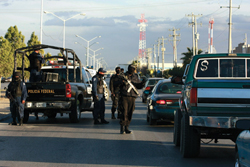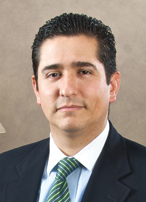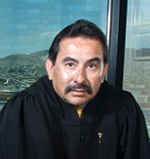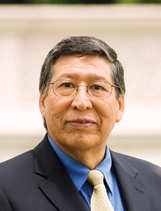Justice in the Rough

Photo by Christ Chavez
In the early morning hours of May 17, 2008, Willy Moya had just closed the V-Bar, one of several popular nightspots he owned in the Pronaf section of Ciudad Juarez, when a couple of friends wandered in and told him they were hungry. Moya decided he could use a bite, so he offered to send one of his bodyguards out for pizza.
Even in ordinary times, Moya had a few bodyguards. But this was no ordinary time in Juarez. The Mexican city of 2 million was averaging more than 100 murders per month.
Storefronts, markets and restaurants were reducing their hours or closing their doors. Lawyers, doctors, judges and policemen—even the city’s mayor—were moving across the river to the safer environs of El Paso, Texas. Married to an American, Moya had already moved to a sprawling, Spanish-style ranch home in El Paso’s Country Club neighborhood.
Moya had no real fear of the violence, according to several acquaintances. He strolled casually into the V-Bar parking lot to dispatch one of his protectors for a couple of late-night pies. As Moya walked toward his bodyguards, a small vehicle cruised by.
Shots were fired from the car in a slow-motion drive-by. Hit seven times, he was dead by the time he reached the city’s General Hospital.
Wilfredo Moya Estaco and his family had been fixtures in the nightlife of Juarez for decades. But his murder barely made news the following day. In the hours before and after his assassination, nine others were killed in far-flung parts of the city.
Three bodies were found in the Melchor Ocampo neighborhood inside an abandoned ’92 Dodge—two stuffed in the trunk, hands and feet bound. Across town in the Colonia San Antonio, a man was shot at the wheel of his Toyota bearing Texas plates. In the central business district, a man was killed at a gas station. A 29-year-old shopkeeper was found, his throat slit, inside his store. A couple cruising in their late-model Mercedes were hit with bullets from an AK-47 as they slowed for a stop sign.
The months of murders were attributed to a turf war between drug cartels. Two thousand people were slaughtered in a little more than a year. The killings took place at all hours and in every gruesome way imaginable. Some were tortured or burned or mutilated. Bodies were dumped in empty lots, in school yards, beneath bridges.
THE LOCKDOWN

Miguel Sarre
Photo by AP Images
Marisela Vargas
By the first week of March of this year, the Mexican government mobilized 3,200 federal troops, placing the city, in effect, under martial law. Soldiers patrolled the streets, watched the border crossings, manned the dispatch boards and typed police reports. The local police department, corrupt and incompetent, was dismissed and replaced with new officers with no ties to Juarez—or former officers who would pass lie detector tests.
The killings slowed almost immediately to a trickle, and an uneasy quiet returned to the streets of Ciudad Juarez. At least for a time.
But even as the narco-violence was on the rise, the situation was more complex than the screaming headlines would lead one to believe. There were changes afoot, both worrisome and encouraging, in the culture of Juarez.
Much of the violence, according to lawyers and other observers, was the result of mere thugs taking advantage of a community destabilized by the drug wars and burdened by a justice system that lacked public trust.
But even as the body count rose, in courtrooms and prosecutors’ offices there was hope that a profound transformation of the Mexican justice system now under way may help the police and courts act as a bulwark the next time crime begins to spin out of control.
Recent changes in the national constitution—now in the process of a state-by-state implementation—honor for the first time a presumption of innocence for anyone accused of a crime. Trials are open to the public. A system that had no probation and all but forbade plea bargains by prosecutors now encourages alternatives to trial. And trials that were once a liturgy of foregone conclusions have become transparent and, to a point, adversarial—overseen by three-judge panels instead of a single, often-corruptible, magistrate.
A system built on the colonial-era codes of the Spanish, the French and a variety of Mexican monarchs of European descent is being transformed into a more accountable and more effective justice system. At least that’s the hope.
“These are dramatic changes, so long as they’re implemented as everyone intends them to be,” says Miguel Sarre, a law professor at the Instituto Tecnologico Autonomo de Mexico in Mexico City. “It is a major commitment to the modern rule of law.”
“There is no doubt that it has set us back,” says Ramon Garcia Ortega about the violence. Garcia is the state prosecutor in charge of implementing the new criminal procedures in the northern district of Chihuahua, which includes Juarez. “Security is now our biggest concern at the moment. There are always obstacles, and we will overcome them.”
Implementation of the changes is scheduled to be finished by 2016. Can the reforms correct the fundamental flaws in the Mexican justice system? Will those who enforce and adjudicate the laws earn the citizens’ respect? Those questions will not be answered until long after the troops are gone.
BORDER TWINS

Fernando Hernandez Romero
Photo by Christ Chavez
On the entire 1,960 miles of border between the U.S. and Mexico, there is no metropolitan area quite like El Paso-Juarez. Founded by Spanish explorers as El Paso del Norte in 1669, the two existed as a single city until 1848, when the Treaty of Guadalupe Hidalgo set the Rio Grande River as the boundary between the two countries. But even after the division, their histories remained intertwined.
El Paso became a hub for railroads, cattle drives and cavalry soldiers. Bandits and smugglers thrived on both sides of the border. Landholders chased from their ranches by Pancho Villa in Chihuahua fled to safety in El Paso. El Paso merchants hedged their bets by smuggling dry goods and ammunition to both sides of the Mexican Revolution. From early on, drugs were plentiful in Juarez—first opium imported by Chinese immigrants, then heroin trafficked by the infamous “La Nacha,” followed by massive inventories of marijuana and cocaine.
Today, the El Paso-Juarez area—fueled by NAFTA, the 1994 North American Free Trade Agreement—is one of the busiest manufacturing hubs in the world. In Juarez, hundreds of factories known as maquiladoras assemble toys, televisions and more for delivery to the U.S. from parts imported from across the planet. In 2007, Juarez was named a top “City of the Future” by Foreign Direct Investment, a Financial Times magazine, because of its importance as a regional industrial and logistics center.
The maquiladoras have brought a new prosperity to Juarez, attracting hundreds of thousands of new residents from the interior of Mexico to create a whole new class of workers, professionals and businesses. And with them, as in any rapidly growing area, have come new levels of urban disorder expressed in housing shortages, pollution, gridlock and crime.
Without a respected justice system to rein it in, ordinary street crime has been left to spiral out of control, according to Fernando Hernandez Romero, a Juarez commercial attorney.
“There’s always been drug wars, but it was just business. A couple of people would be found dead in a house somewhere and everybody would know what it was all about. It was easy to ignore,” says Hernandez, who is a Georgetown University Law Center graduate. “The violence was segregated from civil life. But now civilians are being killed.”
Less newsworthy than the narco-murders, but perhaps more important, he says, is a shocking increase in nearly every category of crime: armed robbery, property theft, kidnapping and extortion. While dead bodies can be easily counted, street crime can’t be quantified without dependable reporting. And street crime won’t be reported without faith in the police.
“Like national security, safety is a matter of perception—and people no longer feel safe,” Hernandez says.

Rogelio Bravo
Photo by Christ Chavez
“Absolutely true,” says Rogelio Bravo, a private investigator in El Paso who hosts a popular local radio show. A change in leadership in the Juarez cartel created a vacuum in the lucrative drug trade that follows the truck routes through Juarez into U.S. markets. The vacuum was filled by gangs hired by the competition from Sinaloa, Guadalajara and Michoacan, he says.
STREET CRIME
“What you’ve got now is a bunch of guys from prison gangs—la Familia, Los Aztecas, Mara Salvatrucha—who are not part of any of the cartels, who are taking advantage of the situation,” Bravo says.
Bravo does much of his work in Juarez, even these days. The two most worrisome crimes for business leaders and their families—those in no way involved in drug traffic—are kidnapping and extortion. It’s what Bravo calls “telephone crime.”
“You own a business. You get a telephone call: ‘You must pay me X amount of dollars or I’ll burn your store down.’ You don’t know who made the call. You don’t know whether it’s a serious threat, but you can’t afford not to treat it seriously. It’s terrifying to the average person.”
Why not call the police? Bravo smiles and notes that the reputed founder of the Juarez cartel, Rafael Aguilar Guajardo, was local commander of the DFS—the Mexican federal police. He was murdered in Cancun in 1993. A Juarez policeman killed last year was alleged to be making $450,000 per month helping protect drug dealers, Bravo says. He anticipates the skepticism concerning the amount.
“Remember, it’s a $70 billion-per-year business,” Bravo says.
For Hernandez and other Juarez lawyers, kidnapping has become an even greater concern. Kidnapping is no longer the bane of just the rich.
It has been democratized. Lawyers, doctors and other professionals are particularly at risk.
“Maybe 15 years ago, you might expect a millionaire guy to be kidnapped for a big ransom,” says Hernandez. “But now normal people are at risk for $1,000. They’ve lowered the standard of ‘kidnappability.’ ”
The flood of violence has had a chilling effect on both sides of the border. For a brief time in El Paso, there was genuine fear that the violence would spill across the banks of the Rio Grande. There were calls for increased security, even for U.S. troops to guard downtown El Paso from marauding Mexicans. But that never happened, and whatever fear there was has morphed into empathy.

Robert Anchondo
Photo by Christ Chavez
“These people are our aunts and uncles, our employees, our friends,” says Judge Robert Anchondo, a criminal court judge in El Paso. “What happens to them happens to us—just not as much.”
Two years ago, as president of the El Paso Bar Association, Anchondo tried to establish a network of lawyers from both sides of the border. The object was to help lawyers in Juarez develop skills that will help them reform their justice system. He pulled together a group that met monthly at informal gatherings in Juarez, but the exchange never had a chance to catch on.
“I thought that there could be great opportunities for both sides, once they got to know each other. But then came the killings,” Anchondo says.
There’s more than just a river separating the two legal communities. There are traditions at odds with one another that go back centuries.
Though many basic rights are spelled out by Mexico’s 1917 constitution, much of Mexican criminal procedure has been based on the Code d’Instruction Criminelle, the so-called Napoleonic Code, enacted by Bonaparte in 1808. The code has been the basis for criminal law in much of Europe and nearly all of Latin America. Many of those countries have modernized their procedures to include U.S.-style trials. Although reforms have been initiated in four of Mexico’s 31 states, criminal proceedings in most of Mexico still look as they did 50 years ago.
THE TRIAL TRAIL
Trials have traditionally been inquisitional—supervised by a single judge who has the authority to investigate the crime. But in actual practice, the trial process has been a lengthy, paper-driven bureaucratic affair. Much of the actual process, along with much of the power, was left to the state or federal prosecutor.

Jorge Vargas
Photo by Frank Rogozienski
“In Mexico, everything is reduced to writing—everything,” says Jorge G. Vargas, an expert on the Mexican legal system and a professor at the University of San Diego School of Law. “Witness statements, confessions, even the questions that are asked of a witness are put on paper.”
Traditionally in Mexico, prosecutors preside over the important early hearings, or “averiguacion previa,” where evidence and witness statements are gathered and assessed. In Mexico, there is still no jury trial, still no grand jury, no case law, no limit on the ability of police to stop and frisk pedestrians, and no bail for defendants charged with crimes more serious than misdemeanors. A defendant formally charged with a serious crime is jailed until trial, a process that can take months or even years.
Criminal proceedings are meant to be accusatory instead of adversarial. Prosecutors present all evidence, including that marshaled by the defense. All of it is introduced in written form, and the most important decisions are made at pretrial hearings, where the reliability of evidence is assessed. Judges frequently delegate decisions concerning evidentiary questions to their law clerks and secretaries, even though the formal record shows the judge as being present. By the time cases reach the trial stage, the verdict and sentence are essentially predetermined.
Vargas says the “civil tradition”—the document-based handling of every aspect of each criminal case —produced a system that demeaned everyone involved. “It was inefficient, lazy and certainly corrupt.”
Under the new system, judges are assigned specific tasks related to pretrial assessments of evidence and the recording of statements. And the notion of oral argument and live witness testimony—an integral part of the new reforms—is utterly revolutionary.
“This is what is really being brought into the system—oralism,” says Vargas, a native of Juarez who predicted 10 years ago that Mexico would be forced to change to trials of record that include live testimony. “Trials take place for which there is no written record; that is ridiculous.”
In part because the court system is grossly mistrusted by many citizens, Mexican law imposes limits on police and prosecutors that make it extremely difficult for criminal cases to be brought in the first place.
One of those limits is “amparo,” a kind of habeas corpus doctrine developed in the Yucatan in the 1840s, a period when Mexico suffered a succession of minor monarchs of European descent who had no regard for individual rights. As originally conceived, amparo gave citizens absolute freedom from specific and impulsive actions of the government—whether in the form of dictators, soldiers or bureaucrats.
Though intended to protect average citizens from abuse, applications of amparo have become very broad and complicated. But it has also become a tool used by sophisticated criminals to avoid detention and arrest. It has been flaunted, according to lawyers in Mexico, by heavyweight criminals, buying them time to cover up evidence or escape arrest. Several attorneys have described it as a get-out-of-jail-free card.
Police in Mexico have very limited powers of arrest. Under a principle known popularly as “flagrancia” (from the Latin “in flagrante delicto”), individual police officers are limited to a very specific set of rules for any arrest they make without a specific warrant: a crime in progress, a “hot pursuit,” a report by an eyewitness or an accomplice. Even that must be made within 48 hours of the crime.
Police have almost no powers to investigate crimes, even when someone confesses. They can “report” confessions, but they are not supposed to interrogate. That power rests with the prosecutor. And although the system has found ways to finesse or ignore them, these rules have deep roots in Mexican society—citizens simply don’t trust the police. This is a point that can’t be overemphasized, says law professor Sarre.
“Our image of policemen is very different from yours. When we [Mexicans] think of police, it is not the same at all. If something bad happens, you’ll look for a police officer. If the same thing happens to a Mexican, that’s not going to happen.”
“I don’t think anybody is satisfied with what we’ve had—not the defendants, not the victims,” Sarre says. “This is a system that was badly in need of change, both for sake of the rights of people as well as the ability to fight real crime.”
Both Sarre and Vargas are cautiously optimistic that the Mexican justice system will be reformed. But success will hinge on a deep cultural change in the attitudes of police, prosecutors, judges and lawyers, they say.
“It’s remarkable that Mexico has made the commitment to change, but it’s been done without the money to do so,” Vargas says. “The changes have to be embedded in the law schools, in the faculty, in the textbooks.”
Sarre says he’s beginning to see changes in the attitudes of his law students. A very short time ago, they would have had zero interest in becoming a prosecutor of any kind, he says. “Any student who told others that he’d like to become a prosecutor would have been ostracized; the others would have wondered what was wrong with him. Now there’s a new attitude. They’re intrigued by the idea,” Sarre says.
ONE CRIME AT A TIME
Sarre and Vargas say the success or failure of the system still depends on how Mexico’s law enforcement and legal professionals do their jobs. There’s no substitute for the day-in, day-out work of catching criminals and honorably prosecuting them. A good place to start may be the murder of Willy Moya—still officially unsolved—which, like a lot of crime and justice south of the border, wasn’t what it seemed at first blush.
Luis Mayans is a Juarez lawyer. He represents a Juarez woman who stepped forward after Moya’s death to claim that Moya was the father of her 16-year-old son. Mayans filed suits on both sides of the border to establish paternity. The claim has already been established through DNA in an El Paso court, which he’ll use to bolster his case south of the border.
“It’s a lot easier to bring an American resolution to a Mexican court than it is to bring a proceeding in Juarez,” he says. “Mexican proceedings just take too long. And now, with the violence, everything takes even longer.”
In the wake of Moya’s death, there were wild rumors—it was a cartel hit, an extortion attempt gone bad, a dispute over money. Mayans suppresses a chuckle when he’s asked his opinion. He knows who killed Moya, he says.
Moya was having an affair, Mayans claims, and the murder was “a passionate killing.” A jealous boyfriend of his paramour gunned him down.
The shooter “fled to the U.S. side and we believe he will be caught—eventually,” Mayans says.



